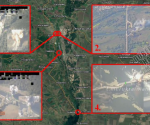Iran calls Trump’s bluff – Trump (with his many helpers) keeps on a-bluffin’ – plus, the readiness crisis goes terminal?
Vali Nasr is a Professor at Johns Hopkins University, a senior fellow in foreign policy at Brookings Institution, life member of the Council on Foreign Relations, and sometime advisor to the Obama State Department, and all this is probably why a tweet of his was advanced to a cluster of search results regarding the topic of the Iranian shooting down of a United States military drone overnight on Wednesday. Amongst the usual detritus, Nasr’s opinion stood out very distinctly; he wrote:
iran has showed that Trump’s assumptions about maximum pressure are wrong. Trump has to think they made a mistake otherwise he has to admit that his great achievement is not Iranian surrender but putting US on path to war
The mistake being referred to is what Trump appears to believe was the result of an itchy trigger finger belonging to a twitchy subordinate in the Iranian air defence forces. To cut a long story short, at some point on Thursday, regarding the downing of the very expensive high altitude, long endurance surveillance drone, Trump vocalised a belief that Iran hadn’t meant to do it.
Hans Nichols, an NBC correspondent, recorded the musings in a tweet:
“I have a feeling that it was a mistake made by someone doing what they shouldn’t have been doing….I find it hard to believe that it was intentional. It could have been someone loose and stupid.”
From this, then, the meaning of Nasr’s tweet becomes clear. He posits that Trump was in denial, because, with the shoot down being deliberate, it puts the Trump regime’s strategy of bullying Iran into submission firmly in the trash can, and instead presents as the way forward [to achieving Trump’s goals as they pertain to Iran] the option that the American military actually doesn’t want (in fact, Nasr doesn’t go so far as to say this – being CFR, he wouldn’t – but it amounts to the same thing).
Now, the strategy in question was written of previously here at FBEL, in an article concerned with the paralysis of American military forces due to something called a “crisis of readiness” (which may again be at the crux of this latest development), and therefore its inability to conduct a war upon Iran. From the article titled, The American military’s “readiness crisis”: why war won’t be waged on Iran, comes the following:
There is intent to pressure Iran to withdraw from its support of, and participation in an anti-Anglo-globalist axis across the Middle East – thus revealing that in the minds of Anglo-globalist planners, Iran itself is an immovable obstacle for their ambitions in the region. The best that can be hoped for – at the moment – it would seem, is reduction of sphere of influence through bargaining (induced by threats and sanctions).
To be clear then, the threat of war has always been that – a threat, because the Americans cannot prosecute it. And it has been one element in a broadly ranged attempt to intimidate Iran – which has included, the author believes, the conspiracy chatter in corporate and big alternative media that the US military encouraged with its ludicrous response to the recent apparent attacks on oil tankers in the Strait of Hormuz. The alternative media especially is a very useful propaganda tool that can be relied on to predict that war is imminent.
Naturally, the Iranian demonstration of strength shows that that country is far from capitulation – the American bluff was called, and all the United States had (and has) in response has been bafflement and more bluffing, with a story emerging on Friday about Trump calling off retaliatory strikes at the last moment – even, preposterously, “with planes in the air”.†
There is no reason to believe there to be any substance to what is essentially toothless posturing: Trump could not even be believable in his rationalisation in reaction to the main event, because the shoot down was announced in Iran, straight off the bat, by Islamic Revolutionary Guard Corps (IRGC) commander-in-chief, Major General Hossein Salami. Even if an operative had jumped the gun, the boss was taking responsibility: the shoot down was a “transparent and firm message” to Iran’s enemies, is what he called it. Of course, when the behaviour of the two sides is put in contrast, one finds the Iranians more authentic. For the Iranian’s part, if they observed the drone violating the sky over their territorial waters, then their reaction was blameless – especially if they issued warnings, as has been reported.
For the Americans, whose own borders are on the other side of the world – lest we forget, contesting the location of the shoot down so that it becomes a violation of international law would clearly be for muddying the waters so that what is in fact a stark humiliation is not to be seen in all its crystal clarity. But in fact, for the bigger picture, this nitpicking is immaterial [unless one is a big alternative media operative dealing in conspiracy chatter to help create an Iranian sense of insecurity]. The bigger picture is that the Iranians shot down a US aircraft, at a time in which they were supposed to be wary of the US bearing down on them with disintegrating warfare, knowing full well that wherever they shot it down there would inevitably be an accusation of foul play by the Americans. In short, the Iranians did not care if the Americans were trying to create a casus belli.
Of course, the Americans were not trying to do any such thing, and there is devil in the detail that tells us this.
Firstly, from the Iranians, is the account of how the drone did not transmit its identity as it approached their territory – it had turned off its transponders after takeoff. Indeed, the Iranians tracked the aircraft for nearly four hours until it was apprehended at 23:35 GMT (19th June): “from Al Dafra Air Base [UAE], through the Strait of Hormuz, and into the Gulf of Oman, all the while in international waters, before returning and flying the same basic route back to base… [except] when the drone came near Kouhmobarak, it turned and entered… [Iranian] airspace” (from The Drive, link below). Essentially, then, the Iranians accuse the Americans of conducting surveillance while making the drone undetectable to civil traffic management measures – therefore, being careful to avoid the production of evidence of territorial violation while undertaking espionage. Logically, if the Americans were not up to anything suspicious, there would be no need to try to hide the drone. And if the drone had a job of work to do, then it wasn’t in the vicinity to become a sacrificed pawn – and at $130 million, quite the expensive one at that.
Secondly, it took the Americans a considerably long time to react to the shooting down of their drone. After opening its report (styled “Everything we know about Iran’s claim” by telling its audience that the US Government was “keeping mum on if an aircraft was lost”, The Drive website updated its article at 00:50 PDT (Pacific Daylight Time), or 07:50 GMT, with news of first verification from Department of Defence sources: “multiple reports that officials within the Pentagon are confirming that this was an MQ-4C.” At nearly half-past eleven, GMT, the article was updated again with news of an official confirmation that the drone had been shot down, and it was in fact a RQ-4A Global Hawk. This model of drone is the one that the story settled on, even though the BBC’s Defence correspondent, Jonathan Marcus, still thought it was a MQ-4C Triton drone in the piece appended to the corporation’s reporting of official US confirmation – which was published about 11-o-clock on Thursday morning, mirroring roughly the time that The Drive reported the same.
So, for twelve hours, the US military did not confirm what the world had already known and had been talking about due to the Iranian announcement. The author suggests that if the drone had been placed in position to be sacrificed for the sake of creating a pretext to go to war with Iran, then there would not have been such a delay in the response. Indeed, an operation to voluminously declare Iran a culprit would have been launched immediately, and the corporate-media would have released material so quickly that it could only have been pre-written.
The long delay suggests that, on the contrary, the downing took the Americans by surprise, and such time was required to stage telephone enquiries up and down the chain of command in order to establish a narrative – which the author feels may well have involved an alteration regarding the type of drone that was lost. For, it appears as advanced and expensive as the RQ-4A is (and, as the Business Insider understands from “drone experts”, being “nearly impossible to shoot down”), it was but a transitory development to the MQ-4C, or as a prototype to it. And of the MQ-4C, The Drive reports that:
To our knowledge, there are no MQ-4Cs in the region. In fact, the MQ-4C is slated to make its very first deployment ever to Guam—which is literally on the other side of the planet—this Summer. This could have changed and it is possible that one deployed in an emergency capacity, but we have no evidence of that as of yet.
After receiving the stories for its first update, the writer at The Drive concludes:
This means the aircraft secretly deployed to the region.
Consider, then, dear reader, the possibility of the supposedly (according to the mythology of US supremacy) relatively technically prehistoric Iranians having shot down, not a model that could be argued away as being expendable, but one that was so new that it wasn’t supposed to be in service. It would be quite the embarrassment if true (while the Iranians have revealed retrieved wreckage, it looks, from the images of it, that it perhaps doesn’t contain any material to distinguish between the particular models, but time will tell) – and one could imagine that it might well present a situation whereby twelve hours was required to get permissions and issue orders in order to deny it.
In fact, the scandal for the Americans might not end there. It turns out that almost a year ago to the very day, a US Air Force RQ-4 Global Hawk malfunctioned and crashed off the Spanish coast. According to the site, USNI News, there followed “two months of silence (until) military officials… acknowledged the crash and recovery”. Quite clearly, then, there is acute embarrassment in the US military about an inadequacy that is actually very commonplace. For a start, the incident over Spain was not the first time an RQ-4 crashed – there was also a prang in California in June 2017. Moreover, in 2014, the Washington Post reported that over 400 US military drones had crashed since 2001, and continued:
Last year, though, set a record for Air Force drone crashes. All told, 20 large Air Force drones were destroyed or badly damaged in accidents last year, the worst annual toll ever, according to a Washington Post investigation…
According to accident-investigation reports and other records, since 2001 there have been 237 military drone crashes that were categorized as ‘Class A’ mishaps: accidents that destroyed the aircraft or caused at least $2 million in damage.
Indeed (via the BBC) the loss of the very drone that the Iranians captured in 2011 by, as they claim, “electronically… hijack[ing] the drone and… steer[ing] it to the ground,” was excused by “US officials” as having “malfunctioned”
Of course, debilitating technical failure due to the US military’s crisis of readiness was the topic of that recent FBEL article abovementioned, and it appears that the manned aircraft that provided the focus of that piece have not been the only sort of flying equipment to have succumbed to the chronic malady that the US military is quite obviously suffering from. Indeed, the silence following the RQ-4 Spanish mishap is perhaps indicative of the way that the US military is dealing with its problem, as posited in said article, by pretending that it isn’t happening.
The author would like to propose another hypothesis: the drone that the Iranians shot down this week also malfunctioned, and strayed into places it never should have on its own volition.
Of course, in the circumstances, the Iranians aren’t going to differentiate between a robot that is handicapped, and one that isn’t – and for the most part, for the bigger picture, it doesn’t matter if the drone did malfunction or not. But it would be ironic indeed if the phenomenon that makes it quite evidently weak (hence no retaliation to this particular incident) – the same that the US military and therefore the Government appears to deny – has had a hand in creating a situation whereby the Iranians have been able to demonstrate that very weakness. All this, too, in a context of the bullying threat of US military might where the Iranians were not supposed to dare to lift a finger.
It’s over for the illusion of US military superiority. For the moment and into the foreseeable future, there isn’t going to be war with Iran, despite what the 9D(imensional) chess merchants in alternative media say.
† Update, 22nd June: The interview mentioned in the text of the following tweet has been recorded and is due to air Sunday, 23rd. Evidently, the necessity to produce baloney from his rear end (to be polished into a diamond and sold as 9D chess-players’ cunning, no doubt) is so imperative that Trump must do what he has apparently never done before: appear on Meet the Press.
#MTP [Meet the Press] EXCLUSIVE: In an exclusive interview with @chucktodd, President Donald Trump says he hadn’t given final approval to #Iran strikes, no planes were in the air.
No comment is required.


















